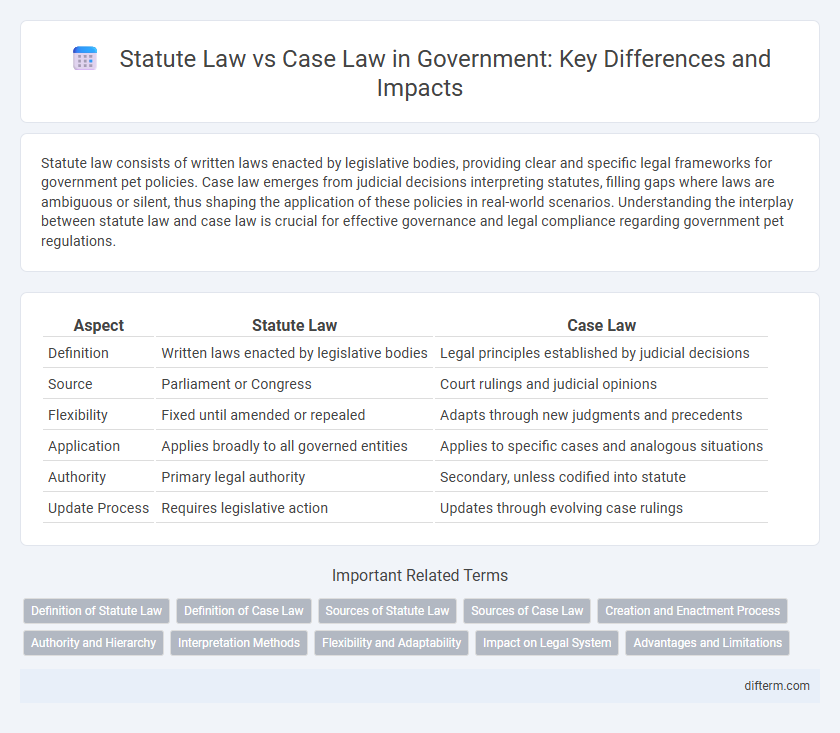Statute law consists of written laws enacted by legislative bodies, providing clear and specific legal frameworks for government pet policies. Case law emerges from judicial decisions interpreting statutes, filling gaps where laws are ambiguous or silent, thus shaping the application of these policies in real-world scenarios. Understanding the interplay between statute law and case law is crucial for effective governance and legal compliance regarding government pet regulations.
Table of Comparison
| Aspect | Statute Law | Case Law |
|---|---|---|
| Definition | Written laws enacted by legislative bodies | Legal principles established by judicial decisions |
| Source | Parliament or Congress | Court rulings and judicial opinions |
| Flexibility | Fixed until amended or repealed | Adapts through new judgments and precedents |
| Application | Applies broadly to all governed entities | Applies to specific cases and analogous situations |
| Authority | Primary legal authority | Secondary, unless codified into statute |
| Update Process | Requires legislative action | Updates through evolving case rulings |
Definition of Statute Law
Statute law refers to laws formally enacted by legislative bodies, such as parliaments or congresses, providing specific legal rules and regulations. Unlike case law, which emerges from judicial decisions and precedents, statute law is codified and written, offering clear directives that govern behavior across jurisdictions. It serves as a primary source of law, often overriding conflicting case law and ensuring consistency in legal interpretation.
Definition of Case Law
Case law, also known as judicial precedent, consists of legal principles established through the decisions of courts and judges, serving as a binding authority in future cases. Unlike statute law, which is enacted by legislative bodies, case law evolves through interpretations and applications of statutes in specific judicial rulings. The doctrine of stare decisis ensures consistency and predictability in the legal system by obligating courts to follow precedent set by higher courts within the same jurisdiction.
Sources of Statute Law
Statute law originates from formal legislative enactments passed by Parliament or other government bodies, serving as the primary source of legal authority in a jurisdiction. These statutes provide explicit rules and regulations that govern societal conduct, whereas case law develops through judicial decisions interpreting statutes and legal principles. Understanding the hierarchy and interplay between statute law and case law is essential for comprehending legal frameworks and authoritative sources in government systems.
Sources of Case Law
Sources of case law primarily include judicial decisions from higher courts, such as supreme courts and appellate courts, which establish binding precedents for lower courts. These precedents interpret and apply statute law, filling gaps where legislation may be unclear or silent. Case law evolves through continuous court rulings, providing a dynamic and flexible legal framework alongside statutory provisions.
Creation and Enactment Process
Statute law is created through a formal legislative process involving proposal, debate, amendment, and approval by elected legislative bodies before being enacted by the executive branch, ensuring codification and public accessibility. Case law emerges from judicial decisions, where courts interpret statutes or legal principles, establishing precedents that guide future rulings without the need for legislative approval. The enactment of statute law typically involves multiple readings and committee reviews, while case law develops organically through judicial interpretation in trial and appellate courts.
Authority and Hierarchy
Statute law, enacted by legislative bodies, holds primary authority as the supreme legal framework that governs society. Case law, developed through judicial decisions, interprets and applies statute law, establishing precedents that guide lower courts within a hierarchical system. The authority of statute law typically supersedes case law, though courts rely on precedent for consistency and legal predictability.
Interpretation Methods
Statute law is interpreted primarily through the literal, golden, and mischief rules to clarify legislative intent, while case law relies on precedent and judicial reasoning to apply legal principles to specific circumstances. Courts analyze statutory language in statute law cases, emphasizing textual meaning and legislative purpose, whereas case law interpretation involves examining past decisions to ensure consistency and fairness. Both interpretation methods aim to resolve ambiguities and adapt legal standards, with statute law providing codified rules and case law offering dynamic application through judicial discretion.
Flexibility and Adaptability
Statute law provides a structured and predictable legal framework through codified legislation enacted by government bodies, ensuring consistency in governance. Case law offers greater flexibility and adaptability by allowing courts to interpret statutes and apply legal principles to specific, evolving circumstances, enabling responsive adjustments to societal changes. The dynamic nature of case law complements statute law by refining legal rules based on judicial precedents and contemporary contexts.
Impact on Legal System
Statute law provides a clear, codified framework that ensures consistency and predictability in the legal system, enabling efficient governance and enforcement. Case law offers adaptability through judicial interpretation, allowing the legal system to address evolving societal values and complex scenarios not anticipated by statutes. The interplay between statute law and case law is crucial for maintaining a dynamic yet stable legal system capable of balancing rigid rules with flexible judicial insights.
Advantages and Limitations
Statute law provides clear, codified rules established by legislative bodies, ensuring consistency and predictability in governance, while its rigidity can limit adaptability to unique cases. Case law offers flexibility through judicial interpretation, allowing laws to evolve with societal changes and new precedents, though it may lead to unpredictability and inconsistent applications. Balancing statute and case law leverages the strengths of formal legislation with the nuanced insights of judicial decisions to create a dynamic legal system.
statute law vs case law Infographic

 difterm.com
difterm.com